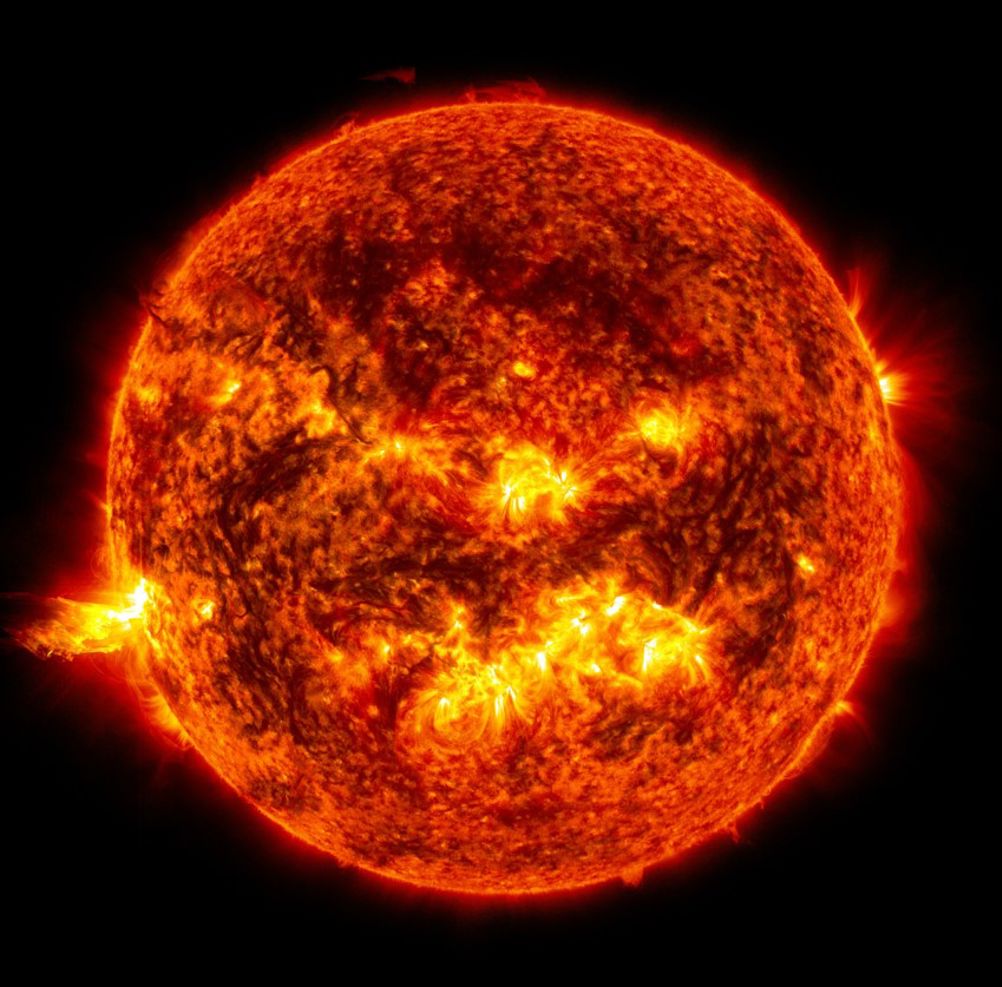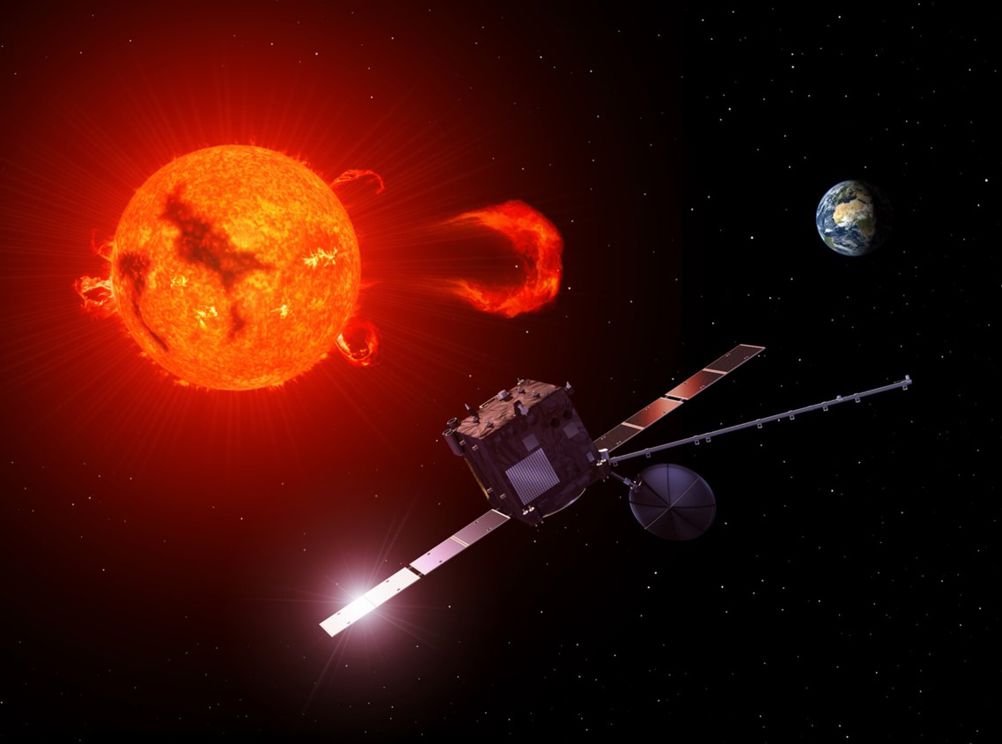A blinding and lasting flash of white light, telegraph wires and towers engulfed in flames ensuing a blackout for days, green hazy hues across the night sky...
Whilst this may seem like the opening scene of an apocalyptic novel, it echoes accounts of the infamous 1859 Carrington event : an extreme geomagnetic solar storm that wreaked havoc on telegraph systems all over Europe and North America, sparked and electrocuted system operators, and produced dazzling auroras that were reported globally.
This geomagnetic storm is thought to have been initiated by a major coronal mass ejection (CME), an expulsion of Earth-directed plasma and magnetic field from the Sun’s corona, which took almost 18 hours to hit.
The event, named after its observer Richard Carrington, remains the largest geomagnetic storm recorded in history, and many believe that our modern technology and infrastructure would experience catastrophic effects if a storm of similar magnitude was to hit Earth today.
Simon Machin, meteorologist and manager of the Met Office Space Weather Programme, defines a solar storm as “anything out of the ordinary that emanates from the Sun. Namely, solar flares, coronal mass ejections and radiation storms.”
Much like terrestrial weather, space weather occurs daily, but experts only consider there to be a ‘significant’ solar storm when the Sun experiences a giant magnetic eruption from its sunspots.
“Of course, there’s ‘weather’ every day, sometimes it drizzles a little bit, and that happens more often than a hurricane,” explained Jonathon Mound, Professor of Global Geophysics at Leeds University. “Experts are aiming to measure how often a ‘super solar storm’ might occur, rather than a smaller storm or milder space weather.”
Only by developing our understanding of the dynamics of the Sun ... will we really be able to forecast space weather events with any certainty
Simon Machin - Manager, Met Office Space Weather Programme
Following magnetic eruptions from the Sun, bursts of electromagnetic radiation including X-rays and ultraviolet light often occur, manifesting as solar flares. These eruptions can also accelerate significant quantities of charged particle radiation into the atmosphere, triggering solar radiation storms that can sometimes reach Earth.
As with the Carrington event, most large eruptions also cause CMEs, which can impact the Earth’s magnetic field and trigger the largest geomagnetic storms.
In October 2023 researchers, including from the University of Leeds, found evidence of a historical radiocarbon spike in the Earth’s atmosphere, attributed to a solar storm larger than any other on record today.
The evidence of the radiocarbon (C14) spike was found by analysing ancient tree rings, preserved within the eroded banks of the Drouzet River in the Southern French Alps. Measurement of the tree’s C14 content was carried out using the AixMICADAS spectrometer, a compact AMS system dedicated to measuring C14 in ultra-small samples. The subfossil tree trunks – natural remains with an incomplete fossilisation – were sliced into individual tree rings for analysis.

When a CME does reach Earth, it can cause a solar storm which disrupts the planet’s magnetosphere, causing the charged particles to collide with Earth’s atmosphere, forming new isotopes, including carbon-14 and beryllium-10. As trees grow, they filter the isotopes out of the air and absorb them in their tissue, thus acting as great indictors of ancient solar activity.
Through analysis of these natural records, researchers discovered a ‘remarkable’ peak in C14, which they predict occurred within a single year, around 14,300 years ago.
Using carbon cycle modelling calculations carried out at CEREGE and Leeds University, researchers were able to compare their findings with records of beryllium-10 found in Greenland ice cores to then attribute the C14 anomaly to a solar flare of exceptional magnitude, ‘the largest ever recorded.’
Edouard Bard, Professor of Climate and Ocean Evolution at the Collège de France, said that the identified historical event was 10–100 times more intense than solar storms recorded during the instrumental period, including the infamous Carrington event, or the March 1989 geomagnetic storm which caused a nine-hour outage of Hydro-Québec’s electricity transmission system in Canada.
The Sun experiences an approximate 11-year solar cycle, driven by its magnetic field and observed by the frequency and intensity of its sunspots. Changes in the Sun’s magnetic field affect the amount of solar activity, often peaking in the middle of the cycle and then decreasing.
The current solar cycle 25, which began in 2019, is predicted to reach its solar maximum of activity as early as 2024, prompting the question: what would happen if a solar storm of great magnitude were to hit Earth today?
Experts predict catastrophic effects on our modern society, with the potential for entire satellite systems and power grids to be completely wiped out, telecommunications networks destroyed, and huge economic impacts as a result.

Speculating on the effect of a major storm today, Professor Mound said: “It could knock out power grid transformers all along the northern US seaboard, leaving an estimated 40m people, just in the North of America, without power for potentially weeks, with an estimated economic loss of trillions.”
The European Space Agency (ESA) conducted its last cost analysis in 2016 and estimated that a major solar event could cost Europe up to €15 billion.
Mound specified that the Sun’s activity can generate huge geomagnetic currents, in excess of hundreds of amps, which can flow through electrical components connected to the grid, such as transformers and sensors. If multiple transformers are damaged, a huge outage may ensue, “leaving millions of people without power for potentially weeks at a time.”
Satellites may also be affected by severe space weather, with the possibility of them sustaining permanent damage, and essentially becoming orbital debris.
Machin added: “Space weather ‘pumps up’ the outer atmosphere, the thermosphere, which could increase the drag on satellites in low-Earth orbit, and therefore could alter their orbital trajectories. This can lead to a greater risk of collisions and conjunctions on orbit, or satellites re-entering the Earth’s atmosphere at an earlier stage than expected.”
Transport such as railway networks and aviation systems could be affected, creating dangerous blackouts in terms of navigation and scheduling, for example. Additionally, those working in aviation or space could face radiation risks, although that threat is believed to be minimal.
Ultimately, “There could be a whole host of impacts across communications, transport, energy, satellite operations,” said Machin.
“A severe space weather event doesn’t necessarily mean everything will fall over at once, but it’s highly likely there will be a lot of impacts to a lot of different systems, with systems misbehaving in a way that people aren’t used to managing. It’d be a really challenging situation.”
To reflect the magnitude of these effects, space weather has been increased by one level on the UK’s National Risk Register as of this year, to a ‘significant’ impact and likelihood, in terms of the ‘reasonable worst case scenario’ of ‘severe’ space weather. As such, the UK is investing in tracking and forecasting space weather to ensure that, in the event of a severe solar storm, infrastructure and service providers are prepared.
Meanwhile, ESA is developing its Vigil mission, set to launch in 2029, which - for the first time - will provide the agency’s Space Weather Office with instruments to monitor solar activity from the Sun-Earth Lagrange point 5 (L5) . This vantage point offers a ‘side’ view of the Sun, so the spacecraft can observe activity on the solar surface before the Earth is exposed to them.

Dr Alexi Glover, Space Weather Service Coordinator at ESA, said: “Vigil will provide really unique data, and will feed into existing forecasting processes that currently rely largely on data from Lagrange point 1, just upstream of the Earth.
“We have good, reliable data already, but we only have that one vantage point. The combination of the two will give us lots more rare information on those storm features as they’re travelling towards us, to help us understand if they are Earth directed or if they’re likely to pass by harmlessly.”
The Met Office Space Weather Operations Centre (MOSWOC) is one of a small handful of space weather prediction centres on Earth. It supplies 24/7 forecasts and warnings of space weather, and is constantly working to improve its abilities.
It is missions like Vigil that help MOSWOC track and forecast space weather: “Only by developing our understanding of the dynamics of the Sun and what drives these events... will we really be able to forecast space weather events with any certainty, days ahead,” said Machin.
“With implementing a network of effective monitoring for space weather, we can do some more in the way of modelling, we can improve our models, and therefore inform people about these events further in advance. That enables them to be able to take sensible action to mitigate against potential risks.”

Asked about the likelihood of a severe solar storm hitting Earth in the next 10–100 years, Dr Glover believes it to be “very high”. However, she said it was important to stress that, despite our increasing reliance on technology, its resilience is also growing all the time.
The difficulty that the world faces is predicting exactly when and what sort of timescale experts and providers need to prepare for, in case of a huge space weather event. As such, it is missions like ESA’s Vigil and MOSWOC’s ever-improving forecasting that are developing our understanding of the Sun’s activity and cycle as a whole, and subsequently the properties, direction and timing of space weather events.
The risk of a severe solar storm akin to the Carrington event, is very real. With technologies like Vigil, the hope is that the world is better placed to mitigate against the damage than it was in 1859.











Guest blog: exploring opportunities for hydrogen combustion engines
"We wouldn't need to pillage the environment for the rare metals for batteries, magnets, or catalisers". Batteries don't use rare...